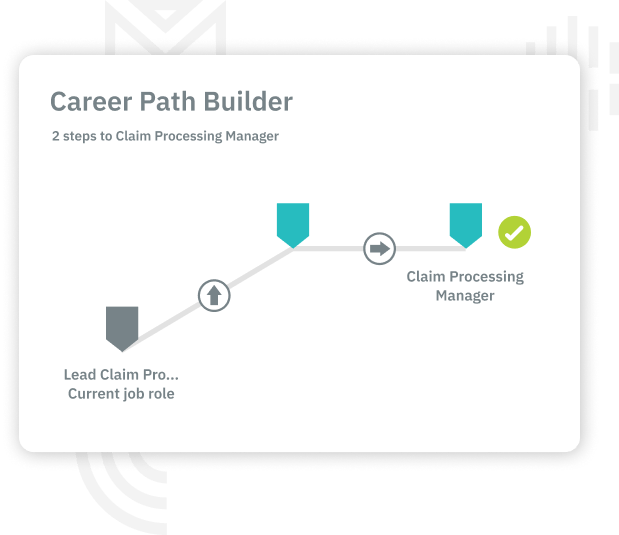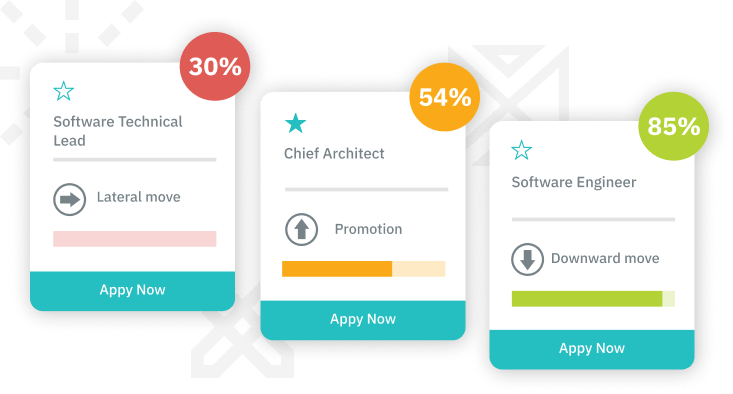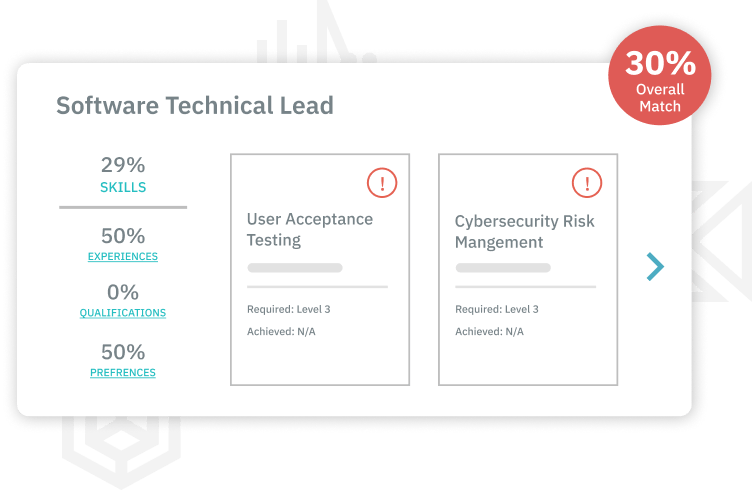Talent Mobility Software
Empower employees to forge their own futures
Our platform gives employees a window into all the opportunities your company offers, so they can clearly envision and work towards a career path that aligns with their skills and life plans.
Talent Mobility Software
Why Talent Mobility Software is Key to Progressive Internal Mobility Programs
Some of today’s most progressive businesses have unlocked the power of internal mobility programs. According to Deloitte Insights, companies that focus on internal recruiting instead of external hiring have better maximized resources and adapted more effectively to changing business environments. Talent mobility software plays a crucial role in making this shift possible.
Here are a few ways internal mobility programs benefit companies:
1. Optimize Talent from Within: Internal mobility programs ensure that companies identify the best candidates from within their current workforce, reducing reliance on external recruiting. This approach improves efficiency, helps businesses find the right fit for roles faster, and saves recruitment costs.
2. Boost Morale and Retention: By prioritizing internal candidates, businesses foster employee growth, improving morale and retention. Employees feel valued and see clear pathways for career advancement, which enhances job satisfaction.
To fully realize the potential of internal mobility, businesses should invest in talent mobility software. These platforms are designed to match employees with new roles based on their skills and experience, making it easier to uncover hidden talent and internal candidates for open positions.
Moreover, talent mobility software facilitates collaboration among leadership, hiring managers, and human resources, creating a transparent and efficient hiring process. It enables teams to work together to track employee development and ensure roles are filled with the best talent available. This seamless integration of technology and human insight simplifies what could be a complex process, especially in larger organizations.
In short, investing in talent mobility software empowers businesses to build stronger internal mobility programs, leading to more efficient recruiting, better talent management, and higher employee satisfaction and retention. If your organization hasn’t yet explored the benefits of this software, now is the time to make it a core part of your talent strategy.

Visibility that sparks initiative
Employees can actively explore their possibilities within the company and build career paths tailored to their competencies and goals, whether they’re aiming for the top or happy where they are.

Agile matching of people and roles
Our competency-based search functions allow employees to search for roles that fit their skills and dreams. This increases internal mobility from the bottom up, helping your company retain its valuable talent.

Growth with purpose
When employees set their sights on a career path, they get a custom development plan based on their current competencies, so they can acquire the skills their desired roles demand.
Get Your Free Demo & See our Platform in Action
Select from one of the bundles below and we will tailored the demo to your needs. Let us show you how TalentGuard’s solutions adapt to your industry.
Free Trial
Free to start
$0
Upfront Commitment
(No hidden charges)
A competency management system loaded with pre-built competencies and job models, designed to streamline skill development, job role creation, competency mapping, and talent management for your organization.
Restrictions apply so please read the eligibility criteria.
Automate
Transform the way your organization defines, manages, and evolves job roles with WorkforceGPT—the AI-powered solution that rapidly generates comprehensive job profiles, skills taxonomies, and career progression maps tailored to your workforce.
WorkforceGPT tracks millions of data points to generate precise, standardized, and up-to-date job architectures—all in a fraction of the time it takes with traditional methods.
With our AI-driven system, you can:
- Create Smart Job Descriptions – Standardize language and tone across roles effortlessly.
- Build AI-Powered Skills Taxonomies – Define skills, clusters, and proficiency statements with accuracy.
- Seamlessly Map Skills to Roles – Align required skills and proficiencies across job grades.
- Enable Dynamic Career Pathing – Real-time updates based on employee movement.
- Deliver Personalized Learning Paths – Address individual skill gaps with just-in-time development.
- Gain Predictive Skill Insights – Stay ahead of workforce demands.
Engage
Employees need clear career paths, relevant skills development, and personalized learning opportunities to stay ahead. TalentGuard’s Engage Package leverages AI to provide employees with real-time upskilling, career pathing, and development planning that aligns with organizational needs.
What’s Included in the Engage Package? Everything in Automate, plus:
- Talent Assessment – Gain deep insights into employee skills, experiences, qualifications and areas for growth.
- AI-Powered Career Pathing – Help employees visualize and navigate career opportunities within your organization.
- Personalized Development Planning – Deliver real-time, skill-based learning recommendations tailored to each employee.
- Talent Analytics – Dashboards and reports to help you make data-driven decisions in a snap.
Optimize
The workplace is evolving, and so are the demands on leadership. TalentGuard’s Leadership Optimization Packagehelps organizations navigate generational transitions, build strong leadership pipelines, and adapt to new work paradigms with AI-driven precision.
What’s Included in the Optimize package? Everything in Engage, plus:
- Succession Planning – Identify and develop high-potential talent pools to ensure a seamless leadership transition.
- Performance Management – Set goals, provide feedback, and track performance for leadership growth.
- Certification Tracking – Ensure leaders maintain essential credentials and compliance effortlessly.
- 360 Feedback – Conduct multi-rater leadership assessments to develop well-rounded, high-impact leaders.
Trusted by:




Your workforce is changing. Never be unprepared again.
Read our eBook
Benefits of Internal Mobility for Employers
Many companies face a “talent gap” that they might better help solve by recruiting from the inside instead of always looking outside. As businesses struggle to retain employees and compete for talent, one Wharton study discovered that companies with internal mobility programs can benefit in multiple ways:
- Internal hires tend to perform better than external hires when they start their new jobs.
- Recruits from within also earn average salaries about 20 percent lower than outside recruits.
- In addition, offering employees a chance to gain a wider range of experience and skills can help improve their career prospects and encourage loyalty.
In the past, employees may have thought moves always had to include promotions to benefit their careers. Really, one purpose of internal mobility can include solving skills shortages by training current employees in the skills they need to be more useful in an increasingly demanding environment. Employees may move somewhat laterally to a job with a similar title and pay but still benefit both themselves and their company.
As an example, a customer service representative might have demonstrated her excellent communication skills and product knowledge, so she might be a great candidate to move to inside sales. If a lot of the training for the inside sales job involves learning about the products and company policies, it seems obvious that a successful customer service representative would have an advantage over an external recruit.
While this example employee didn’t initially move to a higher pay grade, gaining knowledge of both departments should increase her value and chances for a promotion later, especially in a company where sales and service are tightly aligned.
Internal Mobility Best Practices
Any business needs to develop their internal mobility policy to help them avoid some potential pitfalls. As an example, Harvard Business Review mentioned a large and unnamed company that suffered because their own internal mobility process involved moving a select group of identified “leaders” quite frequently.
For instance, new projects generally took from three to five years. At the same time, the rotating decision makers seldom stayed on any one project longer than 18 months. This caused two problems:
- Very often, the people they hoped to groom never stuck around long enough to see projects through or for the transient employees to have much accountability for long-term results.
- The bulk of employees who weren’t selected for grooming felt stuck in their positions, and of course, they were the ones who had to take responsibility for the projects.
As a result, quality suffered. In fact, internal auditors found that the company’s version of “internal talent mobility best practices” probably cost the enterprise at least $1 billion a year. To overcome this challenge, the company decided to make a couple of changes that helped turn them around:
- They began extending the needed time in place to meet the demands of various projects, so their mobile talent could see them through.
- They also increased in-place performance rewards, so people who did not get moved around still had a way to benefit.
Situations in various companies differ; however, it’s important to set internal mobility policies that focus upon benefiting the entire company and all employees and not just the careers of a select few.
Internal Mobility Strategy
Despite some potential obstacles, plenty of internal mobility statistics unveil the potential for solid strategies to benefit businesses. For example, one Lever study found that hiring internal has proven three times more efficient and twice as fast as trying to recruit new employees.
For one more benefit of a strategy for internal mobility example, consider that replacing talent that left because they didn’t care for their job prospects at their current company can cost up to double their annual salary. The program itself can help keep employees loyal and engaged. Thus, an internal mobility strategy should include considering employees first for talent hunts, offering employees a clear and somewhat democratic path to inside moves, and keeping an archive of all inside talent.
Of course, talent mobility tools can help implement all stages of this strategy. They display positions and talent in a place where the right people can access and use the information.
Employee Mobility Program
While businesses might supply all employees with an internal mobility PDF to make sure they understand how the program works, they can use an app to actually implement the program. The app will keep the archive of employees and their skills and of open positions. This kind of software can automatically display jobs for employees to apply for an also, offer managers a view of internal recruits to contact.
Developing a talent mobility program can even help shape a company’s culture by giving employees a better view of more facets of business and of course, letting them know that they don’t have to leave to find a different job. Just a few results include lower turnover, more efficient recruiting, and less concern over skills gaps.
In turn, these can all translate into the very tangible benefits of reduced expenses and in the case of improved morale and productivity, higher quality and performance. Indeed, businesses should devise their talent mobility programs with these goals and internal mobility metrics in mind.
